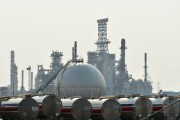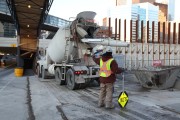Last week, Environment Minister Catherine McKenna and Natural Resources Minister Jim Carr announced Canada’s intention to apply a climate test to major energy infrastructure proposals. This was the fifth of five new principles they announced to improve environmental assessments in the country.
The change is good news because it will fill a long-standing gap in the country’s environmental assessment process. The standard approach has been to look at individual oil pipeline or LNG terminal proposals without worrying about the oilsands mines or gas fields they’re connected to. The new approach will include the carbon pollution from the project being proposed and the carbon pollution from the development associated with it.
What the federal government hasn’t said yet is how they plan to evaluate the new information and integrate it into their eventual decisions. Here are four questions I’d like to see included in their climate test, using Petronas’s Pacific NorthWest LNG project to illustrate how they might work. In many cases, the federal government — as opposed to the proponent — is in the best position to address these questions.
The project is proposed for Lelu Island at the mouth of the Skeena River in northwest B.C. and is a good example of how important it is look at the associated upstream development. The standard approach to environmental assessment would consider the 4 million tonnes of carbon pollution from the LNG terminal — just shy of the emissions from 900,000 cars on the road. Not a small amount by any means, but if the scope is broadened to include the carbon pollution from the connected pipelines, gas processing facilities and gas wells, the number almost triples to 11 million tonnes.
Question 1: Are there opportunities to cut carbon pollution?
One of the reasons for doing environmental assessments is to ensure that proponents are planning to use the best available processes and technologies. In other words, can we build the same project with fewer impacts on the environment? A climate test should help us do a better job of that for large energy projects by looking at the full range of opportunities to reduce carbon pollution. And the same approach should apply for the newly broadened scope of assessment.
In the case of the Petronas proposal, the results aren’t great. Based on our analysis, the 11 million tonnes of carbon pollution the project would be responsible for could be cut in half with better technologies and practices. These include opportunities like using renewable energy instead of gas and reducing methane leaks from gas wells and pipelines.
Some of the opportunities are directly in Petronas’s control. For example, Petronas’s proposal would be powered entirely by gas, but there’s no reason why they couldn’t be using renewable energy. For example, the LNG Canada and Woodfibre proposals — both of which are also in B.C. — intend to use about 20% and 100% renewable energy, respectively.
By expanding the scope of assessment, the revised process should also include opportunities outside of Petronas’s direct control. This is where it seems more appropriate for the federal government to be considering these opportunities as opposed to asking the proponent to do so.
A specific example is the methane that is released from valves and controls along the gas supply chain. These are a significant source of carbon pollution and can be reduced or eliminated with improved technology and better leak detection programs. A recent study by ICF International found that methane emissions from Canada’s oil and gas sector could be reduced by 45% for less than $3 per tonne of carbon pollution. The federal government has the ability to consider analyses like these to determine if there are further opportunities to cut carbon pollution.
Question 2: Are the policies in place to ensure carbon pollution is minimized?
While there is no shortage of opportunities to reduce carbon pollution, there is also no shortage of opportunities not being pursued because of a lack of effective climate policy. Without carbon prices that increase over time and effective regulations, the business case to reduce carbon pollution isn’t strong enough. Where policies are lacking, the federal government can work with the provinces to ensure that any gaps are filled with a mix of provincial and federal policies.
In the case of Petronas, the province’s Climate Leadership Team provided a clear statement that those policies aren’t yet in place. The team concluded that the province was not on track to meet its targets and that B.C.’s carbon pollution was going to rise without new climate policies. They provided the province a package of recommendations — including a number for LNG and natural gas — that would help the province maintain a strong economy and get back on track to cutting carbon pollution. Those recommendations have yet to be adopted by the government, so the carbon pollution from any development that does proceed will be much higher than necessary.
Question 3: Does the project fit within a plan to meet climate commitments?
Canada has pledged to cut carbon pollution so that the country is responsible for at most 524 million tonnes by 2030. And that number will need to continue dropping post-2030. In assessing the carbon pollution from any proposed project, the government should be able to show how that upward pressure is accounted for in their plan to meet their targets in the medium and long-term.
The 11 million tonnes of carbon pollution from Petronas’s LNG project and the associated upstream development would account for over 2% of Canada’s 2030 target. If the government decided to approve the project, they’d need to show how that 11 million tonnes fits into a plan that meets their 2030 target and positions them for further reductions post-2030.
Question 4: Is the project viable as world moves away from fossil fuels?
If the world’s governments collectively achieve the ambitions they agreed to at the Paris climate talks in December, it will mean a rapid shift away from fossil fuels. If that happens, there will be abundant global supply of oil, gas and coal, without anyone wanting to buy it. In that scenario, will Canadian suppliers of fossil fuels be able to compete for an ever-shrinking market or will they be priced out? While we can’t answer these questions definitively today, the cabinet should consider them and the economic risks they could pose to the country.
I co-authored a paper looking at the role of natural gas in a world with strong climate policies. In this scenario, gas demand peaks in 2030 and drops below current levels by mid-century and continues to decline after that. Those numbers are based on scenarios in which the world avoids two degrees of warming. If we get close to avoiding 1.5 degrees of warming, which was the agreement in Paris, the peak in global gas demand will need to be sooner and lower.
Petronas says they want to be operating by 2020, which is 10 years (or less) before global gas demand would peak and then begin a 50-year decline. How robust is their business case to that drop in demand and the accompanying drop in price? It’s possible they could be one of the suppliers that manage to stay afloat. It’s also possible they could sink. The government should be aware of those risks in making its decision.
So there you have it — four questions that should be on Canada’s new climate test when it deliberates on the carbon pollution associated with major energy projects. They aren’t easy questions to answer, but tests aren’t supposed to be easy. They’re supposed to make you think.
Notes:
- In this article, we use a Global Warming Potential (GWP) of 34 for methane emissions in calculating the carbon pollution from the Petronas LNG project and associated upstream development. The backgrounder on the project that we published in July 2014 has slightly lower numbers because we used a GWP of 25 for methane.
- The carbon pollution estimates for the Petronas project and the associated upstream development are based on phases 1 and 2 (19.2 million tonnes of LNG per year) of the proposal going ahead.







